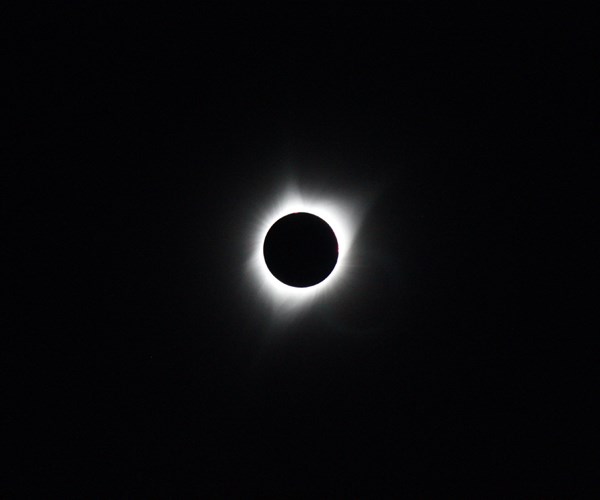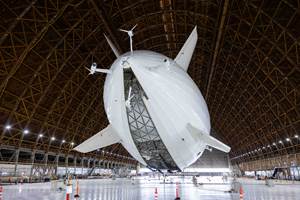A total eclipse of the sun
The humbling, startling, dusky, stunning unreality of a total eclipse of the sun.

August 21 solar eclipse, Imogene Lake, Idaho. (Source: Thomas Sloan)
My oldest son, Thomas, suggested in late July that he was thinking about backpacking into the Sawtooth Wilderness in southern Idaho the weekend before Aug. 21 to bear witness to the totality of a solar eclipse, which was to occur at 11:30 am on that day. He invited a couple of friends to go with him, but they were not available. So, he invited me.
We brought with us Leo, our 1-year-old Golden Retriever, drove 13 hours, arrived at the trailhead on Sunday, Aug. 20 and hiked about 5 miles in to Hell Roaring Lake, where we pitched our tents for the night. The next morning, Aug. 21, at 8:30 am, we hiked another 4 miles to Imogene Lake, and at 10:30 am found a spot along the east side of the lake that offered a great view of the water, mountains and sun, which had, not long before we arrived, cleared the peaks behind us. There were other people there, on the other side of the lake, in small groups, sitting on rocks and outcroppings.
Using our welding glass, we monitored the progress of the moon as it crept slowly in front of the sun, while Leo cooled off in the lake. We were struck, throughout this process, how persistent the sun’s energy and intensity was. Even as the eclipse exceeded 50% totality, there was little discernable difference in the light we could see and feel about us. And it was not until the eclipse reached about 90% totality that we noticed the temperature starting to drop and the color about us in the water, trees and mountains beginning to drain. And then, suddenly, the bees and flies that had found us so interesting all morning, simply vanished. Leo removed himself from the lake and sat next to us on the shore.
Totality struck quickly, as if a veil had been gently draped over the sky, and we were plunged not into total darkness, but a surreal dusk. Jupiter emerged directly overhead. Someone across the lake bellowed in approval. We put down the welding glass and, for the first time, looked at the eclipse with naked eyes. The moon was a solid black disk surrounded by solar prominences protruding in white, gauzy filaments. For 2 minutes it persisted and we consumed, as much as we could, the world around us.
A total eclipse is visually stunning for all of the obvious reasons: The sun is almost perfectly blotted out, day becomes dusk, planets snap into view, the whole world feels closer and smaller. But a total eclipse is remarkable for another reason as well: It offers a complete and thorough disruption of the light cycle rhythm that marks our daily existence. It inserts night when we know it is day. It alters a force of nature that is unalterable. It quietly and gradually suspends our daily reality with with unreality. The world paused, and we paused with it.
And then, just as quickly, it was over. Bright yellow light reanimated itself. Color re-saturated trees, rocks, water. Bees and flies returned, regrettably. Leo jumped back in the water. Thomas and I sat for another 45 minutes and absorbed this gradual restarting of the world and talked about all that we’d seen and felt. Then, we packed up, coaxed Leo of out the water and began our trek back down the mountain.
The next total eclipse in the US is in 2024. Perhaps I will see you there.

Leo, post-eclipse.
Related Content
Plant tour: Spirit AeroSystems, Belfast, Northern Ireland, U.K.
Purpose-built facility employs resin transfer infusion (RTI) and assembly technology to manufacture today’s composite A220 wings, and prepares for future new programs and production ramp-ups.
Read MoreNext-generation airship design enabled by modern composites
LTA Research’s proof-of-concept Pathfinder 1 modernizes a fully rigid airship design with a largely carbon fiber composite frame. R&D has already begun on higher volume, more automated manufacturing for the future.
Read MorePlant tour: Joby Aviation, Marina, Calif., U.S.
As the advanced air mobility market begins to take shape, market leader Joby Aviation works to industrialize composites manufacturing for its first-generation, composites-intensive, all-electric air taxi.
Read MorePlant tour: Albany Engineered Composites, Rochester, N.H., U.S.
Efficient, high-quality, well-controlled composites manufacturing at volume is the mantra for this 3D weaving specialist.
Read MoreRead Next
Developing bonded composite repair for ships, offshore units
Bureau Veritas and industry partners issue guidelines and pave the way for certification via StrengthBond Offshore project.
Read More“Structured air” TPS safeguards composite structures
Powered by an 85% air/15% pure polyimide aerogel, Blueshift’s novel material system protects structures during transient thermal events from -200°C to beyond 2400°C for rockets, battery boxes and more.
Read MorePlant tour: Daher Shap’in TechCenter and composites production plant, Saint-Aignan-de-Grandlieu, France
Co-located R&D and production advance OOA thermosets, thermoplastics, welding, recycling and digital technologies for faster processing and certification of lighter, more sustainable composites.
Read More






















